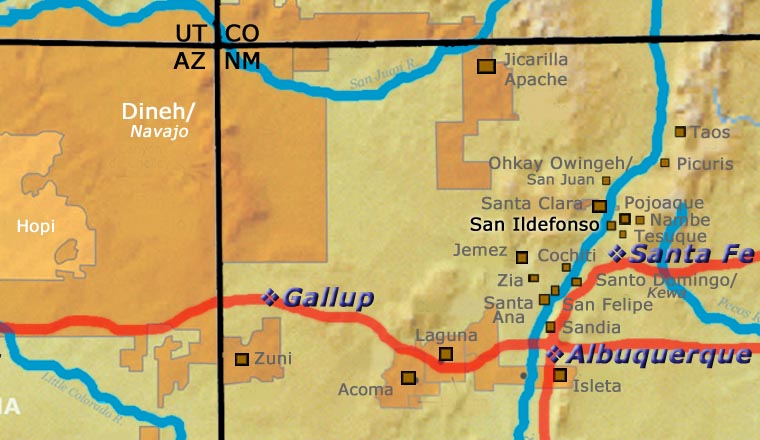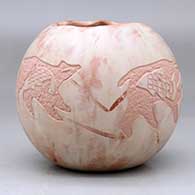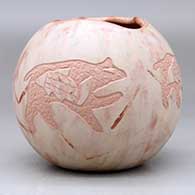
Click or tap to see a larger version
Russell Sanchez, San Ildefonso, A polychrome jar with an organic opening and decorated with a four-panel fish-and-bear design and with an inlaid stone in a bear design on the bottom
San Ildefonso
$ 495
cjsi4j166
A polychrome jar with an organic opening and decorated with a four-panel fish-and-bear design and with an inlaid stone in a bear design on the bottom
4.75 in L by 4.75 in W by 4 in H
Condition: Very good
Signature: Russell Sanchez
Date Created: 1995
Tell me more! Buy this piece!
(505) 986-1234 - www.andreafisherpottery.com - All Rights Reserved
Russell Sanchez
San Ildefonso
Russell Sanchez was born at San Ildefonso Pueblo in 1963. As a child he spent a lot of time with his grandparents, Oqwa Pi (an award-winning painter) and Pomasena Cata Sanchez, Rose Gonzales' younger sister. When Russell was about 8, Rose began teaching him the traditional way to make pottery. He says that one day when he was 11 or 12 he put a batch of small, newly finished black-on-black pots outside and Anita Da (Popovi Da's widow) came by and took a look. Then she told him, "I want you to start bringing me stuff" and that's how his pottery career really began to take off. After a while he also began working with Dora Tse-Pe, Rose's daughter-in-law, and from her he learned how to refine his process and attain a more perfect product. Since then he has developed his own techniques and has often been referred to as a modernist potter.
Because he grew up speaking Tewa, Russell was able to converse with his tribal elders and they told him where to go and what to look for when he went out in search of clay deposits. He found many of the old clay sources at San Ildefonso and has used them to help recreate many of the San Ildefonso styles from the 1800s, well before most San Ildefonso potters started creating black-on-black pots. He's done significant research into old styles and designs among the collections at the Museum of Indian Arts & Culture and the School for Advanced Research but when asked if he copies any he responds with a saying he learned in his youth: "This is mine, this is what I do. Take it and make it your own."
Russell is an avid outdoorsman and an expert with a kayak and a river raft. He's paddled rivers in Peru and Chile and challenged the Zambesi River in southern Africa. However, tamer rivers closer to home allow him to gather clay wherever he finds it. That has led to experiments with many different types of clay, even to the point of incorporating two or more different colors of clay into the same pot. He also often uses slips made of different colors of clay, including micaceous. His designs are painted, carved, incised and sometimes inlaid with turquoise and/or coral and heishi beads. For Russell, "traditional" doesn't mean being stuck in any one time period, it's more like growing and moving forward with everyone adding something else to the "traditional" as they travel their own paths.
Russell has won many awards over the years, including several First and Second Place ribbons at the Santa Fe Indian Market, the Eight Northern Pueblos Arts & Crafts Show and the Heard Museum Guild Indian Fair & Market. Collections of his work can be found at the Millicent Rogers Museum in Taos, New Mexico, the Museum of Natural History in Los Angeles, the Smithsonian Institute in Washington, DC, the Museum of Indian Arts & Culture in Santa Fe, New Mexico and the Heard Museum in Phoenix, Arizona. In 2017 Russell was awarded the 2017 New Mexico Governor's Award for Excellence in the Arts.
Some of the Awards Russell has Won
- 2024 Santa Fe Indian Market, Classification IID: Category 807 - Boundary, Second Place
- 2024 Santa Fe Indian Market, Classification IID: Category 806 - With added elements (like beads, feathers, stones, etc.) any form, Second Place
- 2024 Santa Fe Indian Market, Classification IID: Category 804 - Painted pottery, any form, First Place
- 2021 Heard Museum Guild Indian Fair & Market, Classification II - Pottery, Division C - Carved, native clay, hand built, fired out-of-doors: Honorable Mention. Awarded for artwork: "Black Sienna Jar"
- 2021 Heard Museum Guild Indian Fair & Market, Classification II - Pottery, Division D - Figurative, native clay, hand built: First Place. Awarded for artwork: "Red Bear Lidded Jar"
- 2021 Heard Museum Guild Indian Fair & Market, Classification II - Pottery, Division F - Any design or form with non-native materials, includes kiln-fired pottery: First Place. Awarded for artwork: "Black Gunmetal Water Jar"
- 2021 Heard Museum Guild Indian Fair & Market: Judge's Choice - Charles King. Awarded for artwork: "Red Bear Lidded Jar"
- 2020 Heard Museum Guild Indian Fair & Market, Classification II - Pottery: Best of Classification. Awarded for artwork: Pottery with Detached Lid
- 2020 Heard Museum Guild Indian Fair & Market, Classification II - Pottery, Division B - Unpainted, included ribbed, native clay, hand built, fired out-of-doors: First Place. Awarded for artwork: Pottery with Detached Lid
- 2020 Heard Museum Guild Indian Fair & Market, Classification II - Pottery, Division C - Carved, native clay, hand built, fired out-of-doors: First Place. Awarded for artwork: Pottery with Detached Lid
- 2020 Heard Museum Guild Indian Fair & Market, Classification II - Pottery, Division D - Figurative, native clay, hand built: First Place. Awarded for artwork: "Bear"
- 2019 Santa Fe Indian Market, Classification II - Pottery: Best of Classification
- 2019 Santa Fe Indian Market, Classification II - Pottery, Division D - Contemporary pottery, any form or design, using Native materials with or without added decorative elements, traditional firing techniques: Best of Division
- 2019 Santa Fe Indian Market, Classification II - Pottery, Division D - Contemporary pottery, any form or design, using Native materials with or without added decorative elements, traditional firing techniques, Category 801 - Sgraffito, any form: Second Place
- 2019 Santa Fe Indian Market, Classification II - Pottery, Division D - Contemporary pottery, any form or design, using Native materials with or without added decorative elements, traditional firing techniques, Category 804 - Painted, any form: First Place
- 2019 Santa Fe Indian Market, Classification II - Pottery, Division D - Contemporary pottery, any form or design, using Native materials with or without added decorative elements, traditional firing techniques, Category 805 - Figures, including sets: First Place
- 2018 Santa Fe Indian Market, Classification II - Pottery, Division D, Contemporary Pottery, Any Form or Design, Using Native Materials with or without Added Decorative Elements, Traditional Firing Techniques: Best of Division
- 2018 Santa Fe Indian Market, Classification II - Pottery, Division D, Contemporary Pottery, Any Form or Design, Using Native Materials with or without Added Decorative Elements, Traditional Firing Techniques, Category 801 - Sgraffito, Any Form: First Place
- 2018 Santa Fe Indian Market, Classification II - Pottery, Division D, Contemporary Pottery, Any Form or Design, Using Native Materials with or without Added Decorative Elements, Traditional Firing Techniques, Category 807 - Miscellaneous: First Place
- 2018 Santa Fe Indian Market: Tony Da Memorial Award, “New Vision in Pueblo Pottery.” For Excellence in the Creative and Innovative Use of Traditional Materials and Techniques
- 2018 Heard Museum Guild Indian Fair & Market: Judge's Award - Dr. Arthur Pelberg. Awarded for artwork: Black Mica Polished Water Jar
- 2017 Santa Fe Indian Market: Classification II - Pottery, Division D - Contemporary Pottery, any form or design, using Native materials with or without added decorative elements, traditional firing techniques, Category 801 - Sgraffito, any form: First Place
- 2017 Santa Fe Indian Market: Classification II - Pottery, Division D - Contemporary Pottery, any form or design, using Native materials with or without added decorative elements, traditional firing techniques, Category 805 - Figures, including sets: First Place
- 2017 New Mexico Governor's Award for Excellence in the Arts. Note: public ceremony held September 15, 2017, at the New Mexico Museum of Art, Santa Fe, New Mexico
- 2017 Heard Museum Guild Indian Fair & Market. Classification II Pottery, Division B - Unpainted, Including Ribbed Native Clay, Hand Built, Fired Out-of-Doors: First Place. Awarded for Art Work: Old Style Black Water Jar
- 2016 Heard Museum Guild Indian Fair & Market, Classification II - Pottery, Division D - Traditional - native clay, hand built, figurative: First Place
- 2016 Heard Museum Guild Indian Fair & Market, Classification II - Pottery, Division E - Non-traditional design or form with native materials: Second Place
- 2015 Heard Museum Guild Indian Fair & Market, Classification II - Pottery, Division D - Traditional - native clay, hand built, figurative: First Place
- 2014 Heard Museum Guild Indian Fair & Market, Classification II - Pottery, Division E - Non-traditional design or form with native materials: Second Place with Jennifer Tafoya
- 2014 Heard Museum Guild Indian Fair & Market, Classification II - Pottery, Division G - Pottery miniatures not to exceed three inches at its greatest dimension: Second Place with Nancy Youngblood
- 2013 Heard Museum Guild Indian Fair & Market, Classification II - Pottery: Best of Classification with Jennifer Moquino
- 2013 Heard Museum Guild Indian Fair & Market, Classification II - Pottery, Division D - Traditional, native clay, hand built, figurative: First Place with Jennifer Moquino
- 2013 Heard Museum Guild Indian Fair & Market, Classification II - Pottery, Division C - Traditional, native clay, hand built, carved: Second Place
- 2013 Heard Museum Guild Indian Fair & Market, Classification II - Pottery, Division F - Non-traditional design or form with non-native materials: Second Place with Jennifer Moquino
- 2012 Heard Museum Guild Indian Fair & Market, Classification II - Pottery, Division D - Traditional, native clay, figurative: Honorable Mention
- 2010 Heard Museum Guild Indian Fair & Market, Classification II - Pottery, Division D - Traditional, native clay, hand built, figurative: Honorable Mention
- 2010 Heard Museum Guild Indian Fair & Market, Classification II - Pottery, Division F - Non-traditional design or form with non-Native materials: First Place
- 2010 Heard Museum Guild Indian Fair & Market, Classification II - Pottery, Division F - Non-traditional design or form with non-Native materials: Second Place
- 2009 Heard Museum Guild Indian Fair & Market, Classification II - Pottery: Best of Classification
- 2009 Heard Museum Guild Indian Fair & Market, Classification II - Pottery, Division D - Traditional - hand-built, figurative: First Place
- 2009 Heard Museum Guild Indian Fair & Market, Classification II - Pottery, Division E - Non-Traditional Design or form with non-Native materials: Honorable Mention
- 2008 Heard Museum Guild Indian Fair & Market, Classification II - Pottery, Division C - Traditional, native clay, hand built, carved: First Place
- 2007 Heard Museum Guild Indian Fair & Market, Classification II - Pottery: Best of Classification
- 2007 Heard Museum Guild Indian Fair & Market, Classification II - Pottery, Division D - Traditional - hand-built, figurative: First Place
- 2007 Heard Museum Guild Indian Fair & Market, Classification II - Pottery, Division E - Non-Traditional Design or form with non-Native materials: First Place
- 2007 Heard Museum Guild Indian Fair & Market, Classification II - Pottery, Division F - Non-traditional design or form with non-native materials: First Place
- 2006 Heard Museum Guild Indian Fair & Market, Classification II - Pottery: Best of Classification
- 2006 Heard Museum Guild Indian Fair & Market, Classification II - Pottery, Division C - Traditional - Native clay/hand built/carved/ribbed/incised: Second Place
- 2006 Heard Museum Guild Indian Fair & Market, Classification II - Pottery, Division D - Traditional -native clay/hand built, figurative effigies, canteens, plates, storytellers, nativity scenes: Second Place
- 2006 Heard Museum Guild Indian Fair & Market, Classification II - Pottery, Division F - Non-traditional design or form with non-native materials: First Place
- 2004 Santa Fe Indian Market, Classification II - Pottery, Division H - Non-Traditional Pottery Using Traditional Materials and Techniques with Non-Traditional Decorative Elements, Category 1501 - Jars, Wedding Jars, and Vases: First Place
- 2004 Santa Fe Indian Market, Classification II - Pottery, Division H - Non-Traditional Pottery Using Traditional Materials and Techniques with Non-Traditional Decorative Elements, Category 1502 - Bowls: Second Place
- 2004 Santa Fe Indian Market, Classification II - Pottery, Division H - Non-Traditional Pottery Using Traditional Materials and Techniques with Non-Traditional Decorative Elements, Category 1503 - Combined Techniques, Any Shaped Vessel: Second Place
- 1979 Heard Museum Guild Indian Arts and Crafts Exhibit, Classification XI - Students - Grades 7 through 12, Division HH - Pottery: Third Place. Awarded for artwork: Pottery
- 1978 Heard Museum Guild Indian Arts and Crafts Exhibit, Classification X - Students - Grades 7 through 12, Division HH - Pottery: Second Place. Awarded for artwork: Seed pot
- 1978 Heard Museum Guild Indian Arts and Crafts Exhibit, Classification X - Students - Grades 7 through 12, Division HH - Pottery: Third Place. Awarded for artwork: Etched jar with turquoise
- 1977 Heard Museum Guild Indian Arts and Crafts Exhibit, Classification XI - Students - Grades 7 through 12, Division GG - Pottery: Second Place. Awarded for artwork: Wedding vase
- 1977 Heard Museum Guild Indian Arts and Crafts Exhibit, Classification XI - Students - Grades 7 through 12, Division GG - Pottery: Honorable Mention. Awarded for artwork: Black bear with stone
San Ildefonso Pueblo

Black Mesa at San Ildefonso Pueblo
San Ildefonso Pueblo is located about twenty miles northwest of Santa Fe, New Mexico, west of Pojoaque, south of Santa Clara and straddling the Rio Grande. Although their ancestry has been traced to prehistoric pueblos in the Greater Mesa Verde area, the prehistoric pueblo at Tsankawi, in a non-contiguous parcel of Bandelier National Monument, is their most recent ancestral home. Tsankawi abuts the reservation on its northwest side.
Franciscan monks named the village after San Ildefonso and in 1617, forced the tribe to build a mission church on top of the village's main kiva. Before that the village was known as Powhoge, "where the water cuts through" (in Tewa). Today's pueblo was established as long ago as the 1300s. When the Spanish arrived in 1540, they estimated the village population at about 2,000.
That mission was destroyed during the Pueblo Revolt of 1680 and when Don Diego de Vargas returned to reclaim San Ildefonso in 1694, he found virtually all the Tewa people camped out on top of nearby Black Mesa. After an extended siege the two sides negotiated a treaty and the people returned to their villages. However, the next 250 years were not so good for them.
The swine flu pandemic of 1918 reduced the pueblo's population to about 90. Their population has grown to more than 600 since but the only economic activity available on the pueblo itself involves creating art in one form or another. The only other work is off-pueblo. San Ildefonso's population is small compared to neighboring Santa Clara Pueblo, but the pueblo maintains its own religious traditions and ceremonial feast days.
San Ildefonso is most known for being the home of the most famous Pueblo Indian potter, Maria Martinez. Many other excellent potters from this pueblo have produced quality pottery, too, among them: Blue Corn, Tonita and Juan Roybal, Dora Tse Pe and Rose Gonzales. Of course, the descendants of Maria Martinez are still important pillars of San Ildefonso's pottery tradition. Maria's influence reached far and wide, so far and wide that even Juan Quezada of the Mata Ortiz pottery renaissance in Chihuahua, Mexico, came to San Ildefonso to learn from her.

San Ildefonso Pueblo at Wikipedia
Pueblo of San Ildefonso official website
Pueblos of the Rio Grande, by Daniel Gibson
Photo is in the public domain
Gonzales Family Tree
Disclaimer: This "family tree" is a best effort on our part to determine who the potters are in this family and arrange them in a generational order. The general information available is questionable so we have tried to show each of these diagrams to living members of each family to get their input and approval, too. This diagram is subject to change should we get better info.
-
Ramona Sanchez Gonzales (1885-), second wife of Juan Gonzales (painter)
- Blue Corn (Crucita Gonzales Calabaza)(1921-1999)(step-daughter of Ramona) & Santiago Calabaza (Santo Domingo) (d. 1972)
- Joseph Calabaza (Tha Mo Thay)
- Diane Calabaza-Jenkins (Heishi Flower) (1955-)
- Elliot Calabaza
- Oqwa Pi (Abel Sanchez)(1899-1971) & Tomasena Cata Sanchez (1903-1985)
- Skipped generation
- Russell Sanchez (1966-)
- Skipped generation
- Rose (Cata) Gonzales (daughter-in-law) (1900-1989) & Robert Gonzales (1900-1935)
- (Johnnie) Tse-Pe (Gonzales)(1940-2000) & Dora Tse-Pe (Gachupin, first wife, Zia, 1939-2022)
- Andrea Tse Pe (1975-)
- Candace Tse-Pe (1968-)
- Gerri Tse-Pe (1963-)
- Irene Tse-Pe (1961-)
- Jennifer Tse-Pe (1960-1977)
- (Johnnie) Tse-Pe (1940-2000) & Jennifer Tse Pe (Sisneros - second wife, Santa Clara)
- (Johnnie) Tse-Pe (Gonzales)(1940-2000) & Dora Tse-Pe (Gachupin, first wife, Zia, 1939-2022)
- Rose' students:
- Juanita Gonzales (1909-1988) & Louis "Wo-Peen" Gonzales (brother of Rose Gonzales husband)(1905-1992)
- Adelphia Martinez (1935-2022)
- Lorenzo Gonzales (1922-1995)(adopted by Louis & Juanita Gonzales) & Delores Naquayoma (Hopi/Winnebago)
- Jeanne M. Gonzales (1959-)
- John Gonzales (1955-)
- Laurencita Gonzales
- Linda Gonzales
- Marie Ann Gonzales
- Raymond Gonzales
- Robert Gonzales
- Juanita Gonzales (1909-1988) & Louis "Wo-Peen" Gonzales (brother of Rose Gonzales husband)(1905-1992)
Some of the above info is drawn from Pueblo Indian Pottery, 750 Artist Biographies, by Gregory Schaaf, © 2000, Center for Indigenous Arts & Studies. Other info is derived from personal contacts with family members and through interminable searches of the Internet.
Copyright © 1998-2025 by


